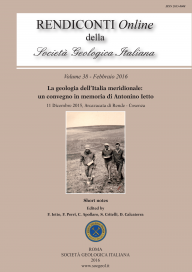
Submarine caves: a laboratory for geomicrobiology studies
Adriano Guido (a), Antonietta Rosso (b), Rosanna Sanfilippo (b), Franco Russo (a) & Adelaide Mastandrea (a)
(a) Department of Biology, Ecology and Earth Sciences, University of Calabria, Via Bucci, cubo 15b, 87036 Rende, Cosenza, Italy. Corresponding author e-mail: aguido@unical.it
(b) Department of Biological, Geological and Environmental Sciences, Catania University, Corso Italia, 57, 95129 Catania, Italy.
Volume: 38/2016
Pages: 62-64
Abstract
Numerous studies have been carried out on microbialite/metazoan associations and their relative role in forming bioconstructions. It has often been suggested that microbial carbonate acts as stabilizing element of the primary skeletal framework. Here we describe unusual bioconstruction occurring in submerged marine caves. They are randomly distributed within the caves, and show different sizes and morphologies, as well as surface roughness/smoothness. These bioconstructions, named biostalactites, are constituted by a few cm-thick crust of serpulids and other metazoans associated with carbonate micrites. All the identified sessile faunas largely consist of cryptic and sciaphilic organisms indicating cave conditions. Biostalactites are the result of the interaction between metazoans and microbial activity. Their distinctive vertical or oblique downward growth from the ceiling and walls of the caves reflects the skeletal/microbial relationship. The skeletal framework produced mainly by serpulids is syndepositionally stabilized by autochthonous microbial induced micrite.
Keywords
Get Full Text